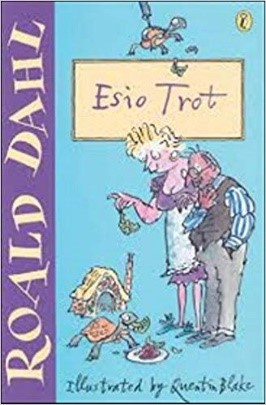
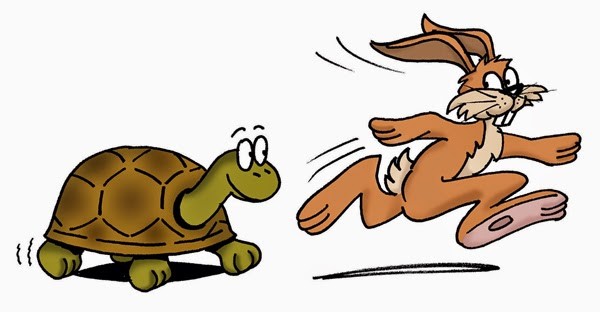
Slow and steady wins the race………
Dearbhla Walsh’s 2015 television film adaptation of Roald Dahl’s Esio Trot depicts the tale of two elderly neighbours, Mrs. Silver (Judi Dench) and Mr. Hoppy (Dustin Hoffman), as they progress towards a romantic relationship. The main obstacle to this relationship is Mrs. Silver’s infatuation with her pet tortoise, Alfie, and her disappointment with his slow rate of growth. Mr. Hoppy devises a plan: to swap Alfie with gradually larger tortoises, to fool Mrs. Silver into believing he has grown and thus to make her happy and to fall in love with him.

The film’s main representation of human/animal relations is concerned with sentimental pet-keeping and the companionship of a pet as a stand-in for a romantic relationship. The notion of the tortoise, Alfie, as a substitute romantic partner, is established by James Corden’s narration in the opening of the film. He informs the audience that Mr. Hoppy’s main obstacle to a relationship with Mrs. Silver is her ‘new chap’, followed by a shot of a young, attractive man. The audience’s assumption that this is the object of her affections is humorously undermined as the camera then pans down to a shot of the tortoise being carried in a picnic hamper: more appealing to the unattached Mrs. Silver is a life-long companion, and perhaps even a picnic, than any sexual relationship with a younger man.
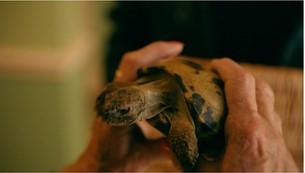
The film appears uninterested in performing a critique of the ethics of animal ownership (through pet-keeping) here, by the sentimentalisation and romanticisation of Mrs. Silver’s relationship with Alfie. The next shot cuts to a close-up of Alfie, held by Mrs. Silver, and not only does he fill the entire shot but the focus also belongs entirely to Alfie as the background blurs: symbolising the tortoise as becoming the centre of Mrs. Silver’s affections. This is followed by a shot of Mrs. Silver and Alfie together, reinforcing the sense of them as a bonded pair. This romanticisation is aided by Walsh’s employment of a piano/violin score and sepia colour grading, lending this scene a sentimental and charming tone.
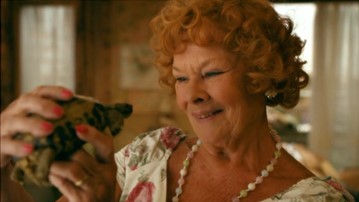
Corden, as narrator, describes Alfie as Mrs. Silver’s ‘wrinkly companion’ and Dench’s character reinforces this notion of the tortoise as a substitute for romantic companionship as, in this scene, she talks to the non-communicative Alfie, confides in him, and even shows him her photo albums.
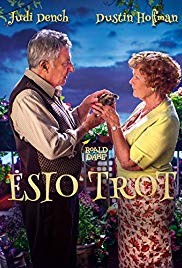
The establishment of the tortoise, Alfie, as the centre of Mrs. Silver’s affections creates an obstacle to the progression of a romantic relationship between herself and Mr. Hoppy which is signified in the film posters and DVD cover for the film in which the couple is facing each other, but the tortoise is always held between them. Despite Mrs. Silver’s affection for Mr. Hoppy, she will not let go of her sentimentalised companion for the prospect of a new relationship.
Not only is Alfie used as a mate for Mrs. Silver – and thus a romantic rival for Mr. Hoppy – but also as a neat mirroring of her character. Russell W. Belk has suggested ‘pet choice [is] shaped by the owner’s personality characteristics’ and arguably, the wizened physicality and slow movement of the tortoise is a mirror of Mrs. Silver, as an elderly individual.[1]
Over all, the film presents the human/animal relation of pet-keeping as sentimentalised companionship for the human that can serve as a substitute for relationships with other humans whilst also conforming to the popular notion that pets reflect their owners’ nature, and vice-versa.
[1] Russell W. Belk, ‘Metaphoric Relationships with Pets’, quoted in Clinton R. Sanders, ‘The Animal ‘Other’: Self Definition, Social Identity and Companion Animals’ in NA – Advances in Consumer Research v.17 (1990) pp.662-668 accessed online at http://www.acrwebsite.org/volumes/7082/volumes/v17/NA-17 [11/11/18].
Bibliography
– Belk, Russell W., ‘Metaphoric Relationships with Pets’, quoted in Sanders, Clinton R., ‘The Animal ‘Other’: Self Definition, Social Identity and Companion Animals’ in NA – Advances in Consumer Research v.17 (1990) pp.662-668.
– Roald Dahl’s Esio Trot (Dearbhla Walsh, 2015).
Suggested further reading
- Dahl, Roald, Esio Trot (London: Jonathan Cape, 1990).
- Gibbs, Laura, Aesop’s Fables (Oxford: Oxford University Press, 2002).
- Herzog, Harold A., ‘Biology, Culture, and the Origins of Pet-Keeping’ in Animal Behaviour and Cognition1.3 (2014) pp.296-308. Access at: https://www.researchgate.net/profile/Harold_Herzog2/publication/268506558_Biology_Culture_and_the_Origins_of_Pet-Keeping/links/546d08500cf26e95bc3cabd8.pdf
- Fox, Rebekah, ‘Animal Behaviours, Post-Human Lives: Everyday Negotiations of the Animal-Human Divide in Pet-Keeping’ in Social and Cultural Geography7.4 (2006) pp.525-537. Access at: https://www.tandfonline.com/doi/abs/10.1080/14649360600825679?casa_token=uqVLvhLIaXIAAAAA:12kwShrlrrbr7n-9QSdZ2GpOUzWF77aBsjoNEgRlqJQpUzbpahDEyvqGbIFwU8e0v7hhj038fhWl
- Clayton, Edward, ‘Aesop, Aristotle, and Animals: The Role of Fables in Human Life’ in Humanitas: Interdisciplinary Journal21.1 (2008) pp.179-200. Access at: http://nhinet.org hhhu/clayton21-1.pdf